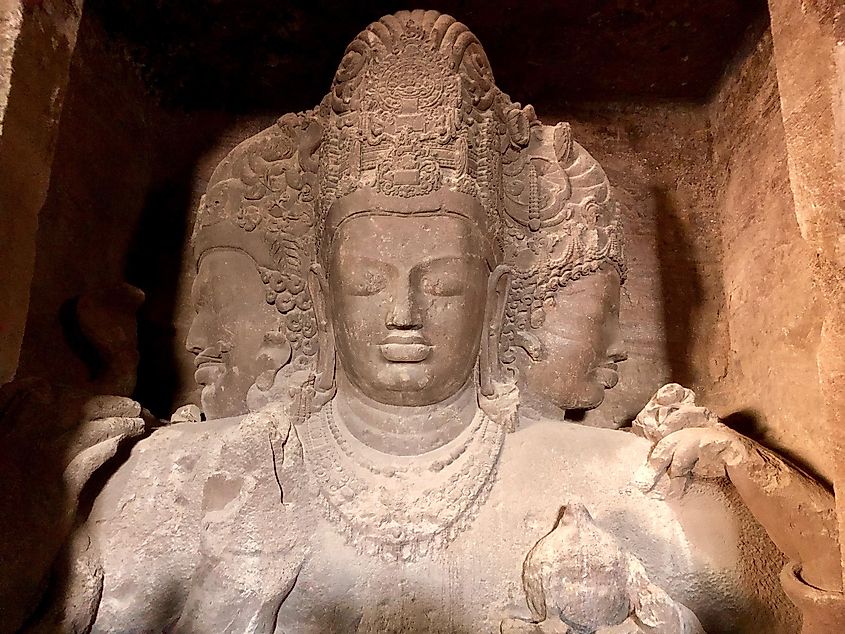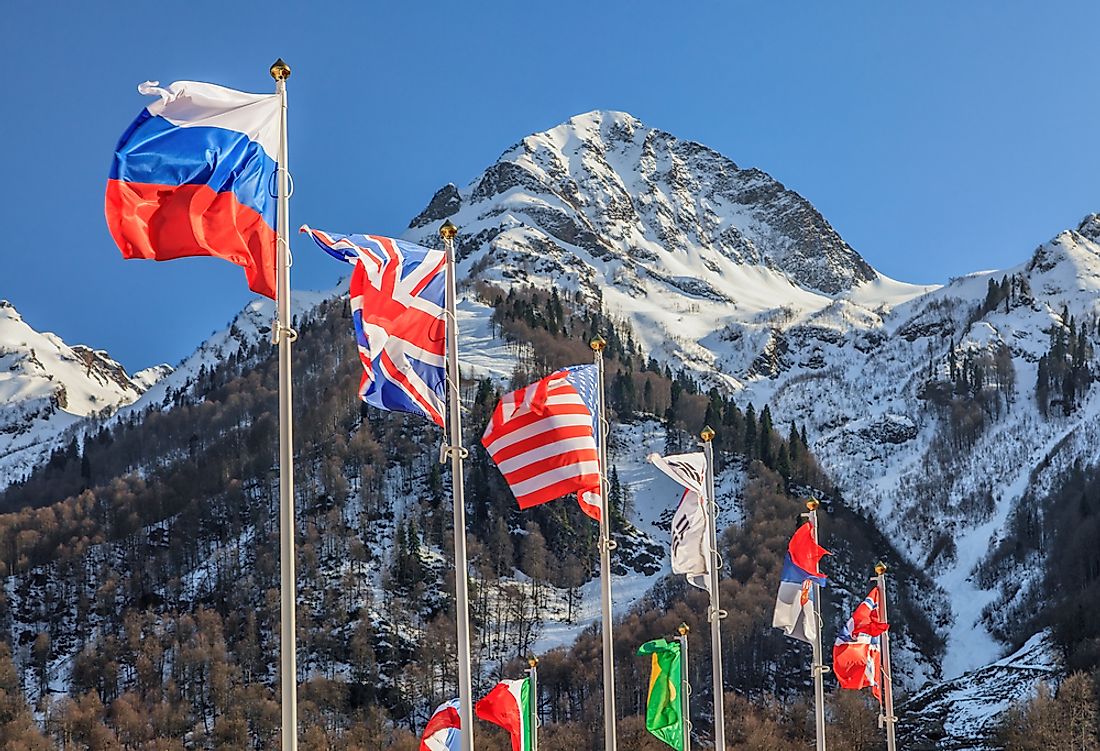Climate Change: a Threat to World Heritage Sites

UNESCO World Heritage Sites represent some of the most captivating chapters in Earth’s history. As of July 2018, the World Heritage list features 1,092 properties across the world of which 209 are natural, 845 are cultural, and the rest are mixed properties. Over 130 of the cultural World Heritage sites have been identified as “at-long-term risk due to sea level rise” in a 2014 study by researchers at the University of Innsbruck and the Potsdam Institute for Climate Impact Research. To understand the true value of such sites and the need to protect them, World Atlas visited the Elephanta Caves of India which is one of the World Heritage properties facing long-term threat from climate change.
Human Genius Finds Expression On Rocks

The Trimurti Sadashiva, one of the most noteworthy sculptures at Elephanta. Image credit: Arijit Nag.
The Elephanta Caves are located on the Elephanta Island, also called the Gharapuri Island or the “city of caves", in the natural, deep-water Mumbai Harbor of the Arabian Sea. An hour-long ferry ride from the busy ferry port at the Gateway of India in Mumbai takes visitors to the island. Once there, visitors can opt to take a 1 km walk along the pier, or jostle their way on to a crowded mini-train, to reach the base of the hill that hosts the awe-inspiring cave sculptures. An uphill climb of around 120 steps flanked on both sides by strings of colorful souvenir shops will then lead to the caves. For those wary of the uphill climb, palanquin services provide an alternative.
Upon entering the caves after purchasing the necessary tickets, visitors are greeted by the awe-inspiring sight of larger-than-life statues of Hindu gods and goddesses adorning the interior walls of the caves. Hindu mythological stories find artistic expression in these sculptures. Caves dedicated to Buddhism are also part of the complex. Of special mention is the Trimurti Sadashiva, which is a three-headed statue representing the three aspects of existence: creation, protection, and destruction.
“Every carving here has a story to tell. These stories provide you an insight into Indian culture and religious beliefs. It also reveals a lot about the Indian sense of beauty,” informed Madhava, a tour guide at the Elephanta Caves.
Historians continue to debate about the origin of these sculptures. Most agree that they were constructed in different stages between the 5th and 9th centuries by various Indian dynasties. Prior to the arrival of the Portuguese invaders, some of these caves served as temples and regular worship rituals were held there. The Portuguese arrival in the 16th century, however, spelled disaster for Elephanta.
Pointing to the scars on many of the carvings, Madhava said:
“When the Portuguese came via the sea route to India, these caves were visited by them. The name ‘Elephanta’ was also given by the Portuguese after a black elephant statue found by them on this island. Unfortunately, these invaders had no regard for art and culture. They defaced and damaged many of the statues, the evidence of which we can clearly see today.”
The marred beauty of these sculptures has, however, not kept tourists at bay.
“These rock carvings are truly impressive. Such intricate details carved so beautifully into rock faces deserves appreciation. No wonder this is a World Heritage Site”, said Vivienne Greene, a tourist from the UK.
Prakash Jha, a domestic tourist, claims “The cave art here makes me feel truly proud of my country. I wonder how ancient Indians could create such magnificent masterpieces with their rudimentary tools. We must protect and preserve our heritage for our children.”
Climate Change Threatens The Future Of World Heritage
In recent years, the local government has adopted several measures to boost tourism to the Elephanta Caves. The Mumbai-Elephanta Caves ropeway project has been planned to connect Mumbai and Elephanta Island via a ropeway system that will reduce travel time between these destinations to only 14 minutes instead of an hour. The island was also electrified by an undersea cable as recently as 2018.
Although such arrangements are expected to boost tourist footfall on the island in the near future and also raise the living standards of the Islanders, human-provoked nature’s wrath in the form of climate change, an acknowledged reality, might make the island inaccessible to all in the distant future.
According to projections, sea levels along the coast of India will rise varyingly by 3.5 inches to 34.6 inches by 2100. Mumbai is predicted to be one of the first victims of climate change in the country. Elephanta Island too will not be spared. Rising sea levels and the increased frequency of extreme weather events will not only cause great loss of lives and property in coastal Mumbai but also on its offshore islands including the Elephanta. The efforts made by the government to promote tourism on the island might just be wasted if extreme weather banishes tourism from the island altogether. Livelihoods of those dependent on tourism will also suffer.

Tourists at the entrance to one of the caves at Elephanta. Image credit: Arijit Nag.
The Same Story Everywhere
The vulnerability of the Elephanta Caves to the changing environment is not an exceptional case. Across the world, hundreds of UNESCO World Heritage properties are at risk for the same reason.
"Virtually every World Heritage site has some level of threat from climate change," Adam Markham, the deputy director of the Climate and Energy Program at the Union of Concerned Scientists informed CNN.
According to an IUCN study that made headlines in 2019, glaciers will disappear from almost half of all World Heritage Sites having them by 2100.
Rising temperatures will also stunt the growth of endemic fynbos in South Africa’s Cape Floral Kingdom. Recognized as one of the world’s most extraordinary collection of flora, vast areas of this floral kingdom will be lost to very large fires triggered by heat waves.

Extreme weather is also damaging the structure of Egypt's World Heritage Properties. Image credit: Arijit Nag.
Even the Yellowstone National Park in the United States is exhibiting signs of stress induced by climate change. Founded as the world’s first national park in 1872, the Yellowstone is known for its glorious landscapes, fascinating geothermal features, and rich wildlife. Scientists are concerned about the growing signs of climate change in Yellowstone. Winters in the park are now shorter, and snowfall is lower. Such changes have a direct adverse impact on the rivers and streams of the park fed by snowmelt which in turn, negatively impacts the park's wildlife.
From the above examples,we can infer that human activities on this planet have managed to threaten the safety of both natural and cultural World Heritage properties with thousands of years of history.
In an interview with the CNN, Mechtild Rossler, the director of the UNESCO World Heritage Centre, mentioned,
"The (World Heritage) Convention says you have to identify those unique sites and transmit it to future generations. If we have nothing left to transmit, this is a dramatic situation.”
To learn more about World Heritage in a changing climate, please see here.




